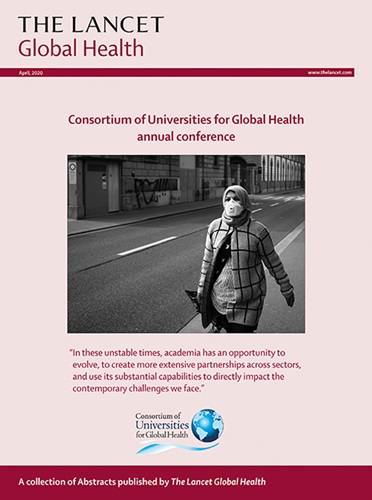Physiologically based serum ferritin thresholds for iron deficiency among women and children from Africa, Asia, Europe, and central America: a multinational comparative study.
IF 19.9
1区 医学
Q1 PUBLIC, ENVIRONMENTAL & OCCUPATIONAL HEALTH
引用次数: 0
Abstract
BACKGROUND Diagnosis of iron deficiency commonly relies on measurement of serum ferritin concentrations. WHO guidelines identify serum ferritin thresholds for iron deficiency among healthy individuals of less than 15 μg/L for women and less than 12 μg/L for children under 5 years, based on expert opinion. We report thresholds for iron deficiency for apparently healthy non-pregnant women and young children based on physiological indicators. METHODS We performed secondary analyses of cross-sectional data from women (aged 15-49 years) and children (aged 6-59 months) from 12 countries in Africa, Asia, Europe, and central America from available surveys (2007-19). Using haemoglobin and soluble transferrin receptor concentrations as individual-level indicators of iron deficiency, we identified country-specific serum ferritin thresholds. We conducted multivariate meta-analysis using individual participant data to assess multinational heterogeneity and intercountry consistency. FINDINGS Data were collected from July, 2007 to March, 2019. 18 251 individuals (13 864 women and 4387 children) were included in the final analysis. The thresholds of pooled serum ferritin levels corresponding to the starting point of decline in circulating haemoglobin concentrations were 24·8 μg/L (95% CI 24·4-25·2) for women and 22·1 μg/L (20·8-23·4) for children based on the national survey data from 12 countries. The thresholds were consistent among countries (pheterogeneity: women=0·73, children=0·43) but median serum ferritin concentrations and lower 5% reference ranges differed. In all countries, the prevalence of iron deficiency was higher using physiologically based thresholds than that using WHO current guidelines for women (36·0% [95% CI 25·3-46·8] vs 20·1% [11·5-28·7], p<0·0001) and for children (34·2% [24·3-44·1] vs 16·6% [11·2-22·0], p<0·0001). INTERPRETATION These results provide evidence that the prevalence of iron deficiency as indicated by physiological measures is substantially higher than those based on current WHO guidelines. The consistency of physiologically based serum ferritin thresholds in apparently healthy women and young children offers a potential means to achieve evidence-informed coordination in thresholds for iron deficiency across populations. The use of physiologically based serum ferritin thresholds could help in detecting the clinical and functional outcomes of iron deficiency. FUNDING None.非洲、亚洲、欧洲和中美洲妇女和儿童铁缺乏的生理基础血清铁蛋白阈值:一项跨国比较研究。
背景:铁缺乏的诊断通常依赖于血清铁蛋白浓度的测定。世卫组织指南根据专家意见确定,健康个体中血清铁蛋白缺铁性阈值,妇女低于15 μg/L, 5岁以下儿童低于12 μg/L。我们报告了基于生理指标的明显健康的非孕妇和幼儿缺铁的阈值。方法我们对来自非洲、亚洲、欧洲和中美洲12个国家(2007-19年)的妇女(15-49岁)和儿童(6-59个月)的横断面数据进行了二次分析。使用血红蛋白和可溶性转铁蛋白受体浓度作为缺铁的个体水平指标,我们确定了国家特异性血清铁蛋白阈值。我们使用个体参与者数据进行了多变量荟萃分析,以评估多国异质性和国家间一致性。数据收集时间为2007年7月至2019年3月。18 251人(13 864名妇女和4387名儿童)被纳入最终分析。根据来自12个国家的全国调查数据,与循环血红蛋白浓度下降起点相对应的血清铁蛋白水平混合阈值,女性为24.8 μg/L (95% CI 24.4 - 25.2),儿童为22.1 μg/L(20.8 - 23.4)。阈值在各国之间是一致的(异质性:妇女= 0.73,儿童= 0.43),但血清铁蛋白浓度中位数和较低5%的参考范围不同。在所有国家,使用生理阈值的缺铁率高于使用世卫组织现行指南的妇女(36.0% [95% CI 25.3 - 46.8]对20.1% [11.5 - 28.7],p< 0.0001)和儿童(34.2%[24.3 - 44.1]对16.6% [11.2 - 22.0],p< 0.0001)。这些结果提供的证据表明,通过生理测量显示的缺铁患病率大大高于当前世卫组织指南。在明显健康的妇女和幼儿中,基于生理的血清铁蛋白阈值的一致性为实现在人群中铁缺乏阈值的循证协调提供了一种潜在的手段。使用基于生理的血清铁蛋白阈值可以帮助检测铁缺乏的临床和功能结果。
本文章由计算机程序翻译,如有差异,请以英文原文为准。
求助全文
约1分钟内获得全文
求助全文
来源期刊

Lancet Global Health
PUBLIC, ENVIRONMENTAL & OCCUPATIONAL HEALTH-
CiteScore
44.10
自引率
1.20%
发文量
763
审稿时长
10 weeks
期刊介绍:
The Lancet Global Health is an online publication that releases monthly open access (subscription-free) issues.Each issue includes original research, commentary, and correspondence.In addition to this, the publication also provides regular blog posts.
The main focus of The Lancet Global Health is on disadvantaged populations, which can include both entire economic regions and marginalized groups within prosperous nations.The publication prefers to cover topics related to reproductive, maternal, neonatal, child, and adolescent health; infectious diseases (including neglected tropical diseases); non-communicable diseases; mental health; the global health workforce; health systems; surgery; and health policy.
 求助内容:
求助内容: 应助结果提醒方式:
应助结果提醒方式:


